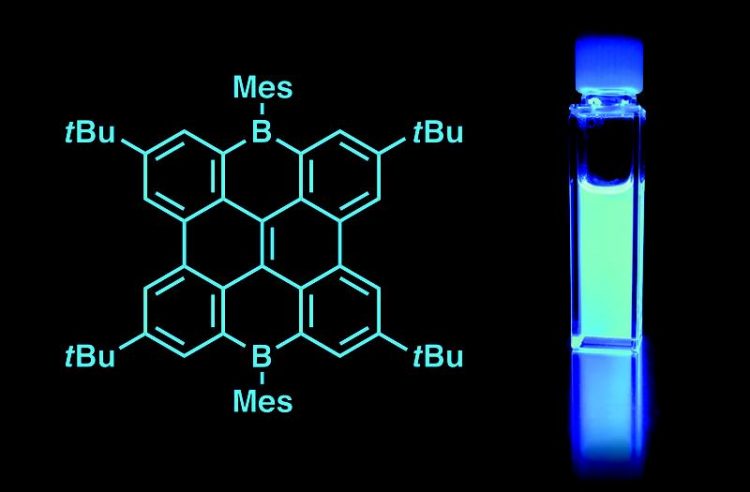New boron compounds for organic light-emitting diodes (OLEDs)

Chemists at the Goethe University have now developed a new class of organic luminescent materials through the targeted introduction of boron atoms into the molecular structures. GU
Major advances in the field of organic electronics are currently revolutionising previously silicon-dominated semiconductor technology. Customised organic molecules enable the production of lightweight, mechanically flexible electronic components that are perfectly adapted to individual applications.
Chemists at the Goethe University have now developed a new class of organic luminescent materials through the targeted introduction of boron atoms into the molecular structures. The compounds described in the professional journal “Angewandte Chemie” (Applied Chemistry) feature an intensive blue fluorescence and are therefore of interest for use in organic light-emitting diodes (LED's).
Carbon in the form of graphite conducts the electrical current in a similar way to a metal. In addition, its two-dimensional shape, the graphene layer, has extremely attractive optical and electronic properties. In graphene, the discoverers of which were awarded the Nobel Prize for Physics in 2010, countless benzene rings are fused to form a honeycomb structure. Sections of this structure, so-called nanographenes or Polycyclic Aromatic Hydrocarbons (PAHs), constitute an important basis of organic electronics.
“For a long time, efforts were largely focused on affecting the properties of nanographenes by chemically manipulating their edges”, according to Prof. Matthias Wagner of the Institute for Inorganic and Analytical Chemistry at the Goethe University. “However, in recent years, researchers have been increasingly capable of also modifying the inner structure by embedding foreign atoms in the carbon network. This is where boron assumes crucial significance.”
A comparison of the new boron-containing nanographenes with the analogous boron-free hydrocarbons verifies the fact that the boron atoms have a decisive impact on two key properties of an OLED luminophore: the fluorescence colour shifts into the highly desirable blue spectral range and the capacity to transport electrons is substantially improved.
To date, only limited use could be made of the full potential of boron-containing PAHs, since most of the exponents are sensitive to air and moisture. “This problem does not occur with our materials, which is important with regard to practical applications” explains Valentin Hertz, who synthesised the compounds within the scope of his doctoral dissertation.
Hertz and Wagner anticipate that materials such as the graphene flakes they have developed will be particularly suitable for use in portable electronic devices. As film displays for future generations of smartphones and tablets, even large-scale screens could be rolled up or folded to save space when the devices are not in use.
Publication
V. Hertz et al: Boron-Containing PAHs: Facile Synthesis of Stable, Redox-Active Luminophores, in: Angew. Chem. Int. Ed. 2015, DOI: 10.1002/anie.201502977;
http://onlinelibrary.wiley.com/doi/10.1002/anie.201502977/abstract
Information: Prof. Dr. Matthias Wagner, Institute for Anorganic and Analytic Chemistry, Riedberg Campus, Tel.: +49 (0) 69 798-29156, Matthias.Wagner@chemie.uni-frankfurt.de
Goethe University has a strong background in research and is based in the European financial center of Frankfurt. Founded in 1914 with purely private funds by liberally-oriented Frankfurt citizens, it is dedicated to research and education under the motto “Science for Society” and to this day continues to function as a “citizens’ university”. Many of the early benefactors were Jewish. Over the past 100 years, Goethe University has done pioneering work in the social and sociological sciences, chemistry, quantum physics, brain research and labour law. It gained a unique level of autonomy on 1 January 2008 by returning to its historic roots as a “foundation university”. Today, it is among the top ten in external funding and among the top three largest universities in Germany, with three clusters of excellence in medicine, life sciences and the humanities.
Publisher: The President of Goethe University Frankfurt, Editor: Dr. Anne Hardy, Advisor for Science Communication, Marketing and Communications Department, Theodor-W.-Adorno-Platz 1, 60629 Frankfurt/ Main, Tel: +49 (0)69 798-12498, hardy@pvw.uni-frankfurt.
Internet: www.uni-frankfurt.de
Media Contact
All latest news from the category: Life Sciences and Chemistry
Articles and reports from the Life Sciences and chemistry area deal with applied and basic research into modern biology, chemistry and human medicine.
Valuable information can be found on a range of life sciences fields including bacteriology, biochemistry, bionics, bioinformatics, biophysics, biotechnology, genetics, geobotany, human biology, marine biology, microbiology, molecular biology, cellular biology, zoology, bioinorganic chemistry, microchemistry and environmental chemistry.
Newest articles

NASA: Mystery of life’s handedness deepens
The mystery of why life uses molecules with specific orientations has deepened with a NASA-funded discovery that RNA — a key molecule thought to have potentially held the instructions for…

What are the effects of historic lithium mining on water quality?
Study reveals low levels of common contaminants but high levels of other elements in waters associated with an abandoned lithium mine. Lithium ore and mining waste from a historic lithium…

Quantum-inspired design boosts efficiency of heat-to-electricity conversion
Rice engineers take unconventional route to improving thermophotovoltaic systems. Researchers at Rice University have found a new way to improve a key element of thermophotovoltaic (TPV) systems, which convert heat…



